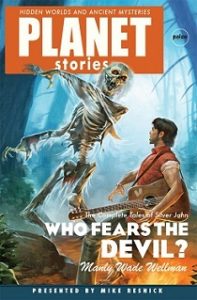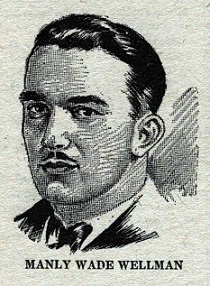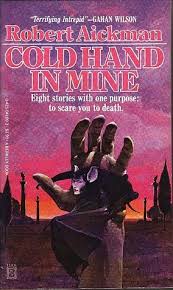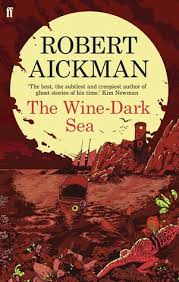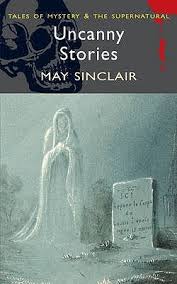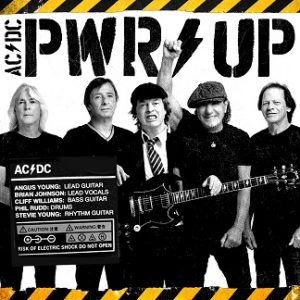
© Alex Barnard / From twitter.com
Thanks to Covid-19, Halloween this year is likely to be shorn of its normal traditions, like trick-or-treating, or guising as it’s known in my part of the world. However, the virus won’t stop me from indulging in my traditional activity on Halloween, which is to post on this blog ten of the most interesting creepy pictures, paintings and illustrations that I’ve come across in the past year.
I recently watched the much-admired 1989 TV adaptation of Susan Hill’s grim 1983 ghost novel The Woman in Black, directed by Herbert Wise and scripted by Nigel Kneale. I was put in mind of The Woman in Black when I saw Listen from Salem, a lushly gothic picture by the American painter, illustrator, comic-book artist, songwriter and multi-instrumentalist Menton J. Matthews III. In particular, it evokes those disturbing shots of the woman standing distantly but ominously on the flatlands around the haunted Eel Marsh House. The figure in Listen from Salem is rather more glammed-up than Hill’s spectre, and has a touch of Helena Bonham Carter about her, but it’s still chilling.

The stories of Edgar Allan Poe have been illustrated by many people over the years, but for my money the most distinguished work was done by Irishman Harry Clarke, who provided pictures for an edition of Poe’s Tales of Mystery and Imagination in 1923. Here’s Clarke’s depiction of the climax of The Facts in the Case of M. Valdemar, one of Poe’s most transgressive stories. It has a mesmerist hypnotising a dying man and keeping him ‘alive’ in an ongoing hypnotic state for seven months after the supposed moment of his death. The experiment ends when the mesmerist finally decides to lift the spell, at which point the patient promptly decays on his deathbed into a ‘nearly liquid mass of loathsome… detestable putridity.’ And presumably leaves a terrible mess on the sheets.

© Brentano’s
I’ve always been interested in Scottish folklore and particularly in the bestiary of fabulous creatures that populate old Scottish folk and fairy tales: kelpies, selkies, redcaps, bean nighe, the Blue Men of the Minch and so on. Surely the most hideous of these legendary creatures is the Orcadian sea monster the nuckelavee which, part humanoid and part horse, has something of the appearance of a centaur. However, it’s a centaur – eek! – without any skin. According to Wikipedia, its “black blood courses through yellow veins” and “pale sinews and powerful muscles are visible as a pulsating mass.” Plus, it has “an enormous gaping mouth that exudes a toxic smelly vapour, and a single giant eye like a burning red flame.” Here’s a depiction of the dreaded nuckelavee by the St Peterburg-based illustrator and digital artist Artem Demura. Though it dispenses with the cyclopean single eye, Demura’s imagining of the nuckelavee gives its humanoid and equine parts fleshless (as well as skinless) skull-faces and is pretty disturbing.

Still on the subject of Scottish folkloric creatures, here’s the Edward Atkinson Hornel painting The Brownie of Blednoch, inspired by an 1825 poem by William Nicholson. The Australian-born, Scottish-reared Hornel was part of the Glasgow Boys circle of painters in the late 19th century and was best known for his renditions of flowers, trees and children. Thus, The Brownie of Blednoch, which hangs in Glasgow’s Kelvingrove Art Gallery and Museum, is atypical of his work. However, despite its subject being a frightful thing with mud-brown skin, Spock ears, three-fingered claws and a long tangling beard, it’s actually benevolent. As a brownie, a type of fairy that does chores for human beings, it’s depicted here performing a public service, which is guarding the local shepherds’ flocks at night-time.

From Kelvingrove Art Gallery and Museum
A popular theme in religious art since the Middle Ages has been the Temptation (or Torment) of Saint Anthony. This supposedly took place while the saint was living as a hermit in Egypt’s Eastern Desert. At one point, demons came to him disguised as beautiful, amorous young women and tried to corrupt him. At another point, a squadron of demons ambushed him while he was in mid-air, being borne along by angels. The scenario has allowed artists over the centuries to let their imaginations run riot in depicting the misshapen and monstrous beings attacking Anthony. I only found out lately that the earliest known painting by Michelangelo dealt with the demons attacking the saint while he was aloft in the skies. Painted sometime in 1487-88, Michelangelo’s The Torment of Saint Anthony is now housed in the Kimbell Art Museum in Fort Worth, Texas.

From the Kimbell Art Museum
Ivan Albright was an American artist who, in the 1940s, was hired to provide a rendering of what is surely the most famous painting in the horror genre, the one featured in Oscar Wilde’s The Portrait of Dorian Gray (1890). For the 1945 movie adaptation of this novel, which stars Hurd Hatfield in the title role, two artists were actually commissioned. Portuguese portraitist Henrique Medina did a normal painting of Hatfield that appears early in the film, while Albright did the utterly repulsive, debased version of it that appears later, after all of Dorian’s sins have manifested themselves on the canvas. Although the film is mainly in black and white, it switches to colour during close-ups of the portrait. I saw the movie on TV in the late 1970s as a supposedly hardened teenager – but I leapt out of my skin when the camera suddenly cut to a colour close-up of the hideous, wizened, festering creature that Albright had created. Incidentally, the painting now resides in the Art Institute of Chicago.

From the Art Institute of Chicago
Still on a cinematic theme, here’s a poster designed by the British artist Graham Humphreys for a film-club screening of Night of the Hunter (1955), the masterly southern gothic horror-thriller starring Robert Mitchum, Lillian Gish and Shelley Winters, directed by Charles Laughton and based on the 1953 novel by Davis Grubb. Prominence on the poster, of course, is given to the smirking and definitely not-to-be-trusted Mitchum. His performance as the serial killer and alleged travelling preacher the Reverend Harry Powell, dressed in black, with the words LOVE and HATE tattooed on his knuckles, is possibly the most memorable one of his career.
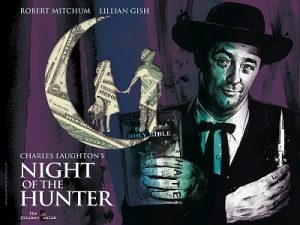
The Australian-American artist Ron Cobb died last month at the age of 83. He was well known for his work as a designer and concept artist on science fiction and fantasy movies such as Dark Star (1974), Star Wars (1977), Conan the Barbarian (1982), Back to the Future (1985), The Abyss and Total Recall (both 1989), with his most famous cinematic commission being Ridley Scott’s Alien (1979). While the disturbingly organic extra-terrestrial spaceship in Alien, and indeed the alien itself in its various life-stages, were designed by the Swiss artist H.R. Giger, Cobb designed the futuristic human hardware in the film, i.e. the exterior and interior of the Nostromo, the spaceship whose crew are unfortunate enough to encounter the movie’s titular, acid-blooded beastie. Away from the movies, Cobb was also a general artist, cartoonist, designer of ‘speculative technology’ and, once in a blue moon, a painter of album covers. Here’s his pleasantly schlocky and ghoulish cover for the ultra-obscure record Doctor Druid’s Haunted Séance which, as far as I can find out, was a weirdo compilation of spoken word performances and spooky music released to tie in with Halloween in 1973.

© Electric Lemon
This gorgeous illustration is by the British artist Ian MacCulloch (not to be confused with Ian McCulloch, the Liverpudlian singer with Echo and the Bunnymen, or indeed Ian McCulloch, the Scottish actor who played the unflappable hero of Lucio Fulci’s Zombie Flesh Eaters in 1979). It isn’t frightening or disturbing as such. But with its wind-lashed trees, overgrown pastures and swirling flocks of black birds, it is very atmospheric and evokes the folk horror sub-genre that many (often British) horror stories, films and TV shows belong to, emphasising natural landscapes and the dark side of old myths and legends. Actually, this picture reminds me of the opening sequence of a seminal work in the British folk horror canon, the 1970 film Blood on Satan’s Claw.

Finally, I’ve recently discovered the work of Richard Tennant Cooper. This English painter was commissioned as a war artist during World War I and also made money designing adverts for the London Underground, painting signs for the Automobile Association and illustrating motoring magazines. But Cooper had an unusual side-line. In addition, he created paintings inspired by diseases like leprosy, cholera and syphilis, depicting those diseases as malignant phantoms tormenting or looming over their stricken victims. Here’s one of tuberculosis that Cooper likely painted in 1912, which I believe is now the property of the Wellcome Collection in London.

From the Wellcome Collection
And on that pestilent note, appropriate in the year of Covid-19, I shall sign off. Happy Halloween!



